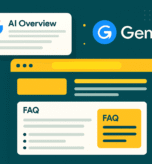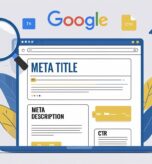Think of your meta title and description as your website’s handshake in Google search. It’s the first thing people see and the first reason they choose to click (or not). If it’s weak, your content might never get a chance. If it’s strong, you’ll stand out even in a crowded search result page. In this blog, we’ll show you how to write titles and descriptions that grab attention, build trust, and drive real traffic without stuffing keywords.
What Are Meta Titles & Meta Descriptions?
Meta titles and meta descriptions are short pieces of text that show up in Google’s search results. They are part of your page’s HTML code and play a key role in how both users and search engines see your content.
- The meta title, also known as the title tag, is the clickable blue link that appears in search engines. It tells both Google and readers what the page is about.
- The meta description is the short summary below the title. It gives users more context and helps them decide whether to click.
Even though meta descriptions don’t directly affect rankings, they improve click-through rates (CTR) by making your page look more relevant and attractive in search results. On the other hand, well-optimized title tags help search engines understand your content better, which can influence your ranking position.
Why They Matter
- A strong meta title grabs attention and includes your target keywords naturally.
- A clear, informative meta description makes your listing more appealing.
- Together, they improve your SEO performance and attract the right audience.
Why Google Likes Well-Written Titles?
Even though meta titles and meta descriptions don’t directly boost your website’s ranking, they are very important for SEO. Here’s why:
- They Improve Click-Through Rate (CTR)
When someone sees your page in Google search results, they decide whether to click based on the title tag and meta description. If both are clear, relevant, and interesting, people are more likely to click.
A higher click-through rate (CTR) tells Google that your page is helpful and matches what people are looking for. Over time, this can lead to better rankings.
- They Match Search Intent
Google wants to show results that match the user’s search intent. That means your meta title and meta description should clearly explain what the page offers. Use natural language and try to include relevant keywords that people might search for.
- They Improve User Experience
If users quickly understand what your page is about, they’re more likely to stay longer. This helps reduce bounce rates, which is a signal of good user experience. Good titles and descriptions set the right expectations and help users find exactly what they’re looking for.
Best Practices for Meta Descriptions That Google Likes
A meta description is a short paragraph displayed under your title tag in Google’s search results. Though it doesn’t directly affect rankings, it plays a key role in improving your click-through rate (CTR) by encouraging users to click your page over others.
1. Keep it in the Optimal Length
Aim for 120–155 characters to ensure your meta description displays fully on both desktop and mobile. Too short, and you miss opportunities; too long, and Google may cut it off.
2. Include Your Primary Keyword Naturally
Include your main keyword or a close match to it once, in a way that matches search intent. This helps Google bold the term in search results and attracts user attention.
3. Match Search Intent
Know the user’s goal: to learn, to buy, or to compare. Your description should clearly explain how your page satisfies that intent without misleading or overpromising.
4. Use Imperative (Action) Language
Writing in a direct, actionable tone (e.g., “Discover,” “Learn,” “Download”) encourages users to click. Make it feel like a helpful mini‑CTA.
5. Write Unique and Specific Copy
Avoid repeating the same description across multiple pages. Make each description match the page content and offer value—this shows Google and users you care.
Common Mistakes to Avoid in Meta Titles and Descriptions
1. Using Duplicate Meta Titles or Descriptions
Google doesn’t like repeated content, and that includes your meta title and meta description. If you copy the same description across multiple pages, search engines may ignore them altogether. Always create unique titles and descriptions for each page that reflect its content clearly.
2. Keyword Stuffing
Using your focus keyword too many times just to rank can backfire. Google can detect keyword stuffing and may see it as spammy or unnatural. Use your primary keyword once in the meta title and once in the meta description. Make it feel natural and helpful.
3. Writing Generic Copy
If your meta text is vague like “Welcome to our website” or “Click here for more,” users (and Google) won’t know what your page is about. Be clear and specific. Explain exactly what your page offers and why it’s useful.
4. Misleading Descriptions
Don’t try to trick users by writing something exciting that doesn’t match the actual content. If people click and bounce quickly, it sends negative signals to Google. Write meta descriptions that match your page content and deliver what’s promised.
5. Not Checking How It Looks on Google
Sometimes your title tag or description gets cut off in the SERP display. If you go over the character limit, users won’t see your full message. Keep meta titles under 60 characters and meta descriptions between 120–155 characters. Use preview tools to see how they’ll appear on Google.
Tools to Help You Optimize Meta Titles and Descriptions
1. Semrush On‑Page SEO Checker
This tool is a must-have for anyone serious about SEO. It checks your pages and offers suggestions to improve your on-page SEO, including your meta tags.
- It highlights missing or weak meta titles.
- Recommends changes to improve keyword targeting.
- Ensures your meta description is relevant and optimized.
2. Google’s Site Audit Tools
Google offers several audit tools that can quickly scan your site and show:
- Missing meta descriptions
- Duplicate title tags
- Pages with long or short meta titles
These insights are helpful for cleaning up your metadata and improving how your pages appear in Google Search.
3. Snippet Preview Tools
Preview tools simulate how your meta title and meta description will appear in the Google SERP (Search Engine Results Page).
- Check if your content fits within the ideal character limits.
- Make sure important keywords are visible.
- Avoid titles or descriptions getting cut off.
SEO Benefit of Internal Linking
Internal linking plays a big role in improving your on-page SEO. It helps Google understand how your content is connected, and it also keeps readers engaged longer.
When you create meta titles and meta descriptions, you should also think about how that page fits into the rest of your website. Adding internal links to related articles helps users explore more and increases your page authority.
Why Is Internal Linking Important?
- Better User Experience: Internal links guide your visitors to helpful content. This makes their journey smooth and informative.
- Improves Crawlability: Search engines follow these links to discover more pages on your site. This boosts visibility and indexing.
- Distributes Link Equity: Linking to related pages passes value (or “SEO juice”) to those pages and helps improve rankings.
Smart Internal Links You Can Use:
If you’re writing about meta titles or meta descriptions, consider linking to these helpful guides:




